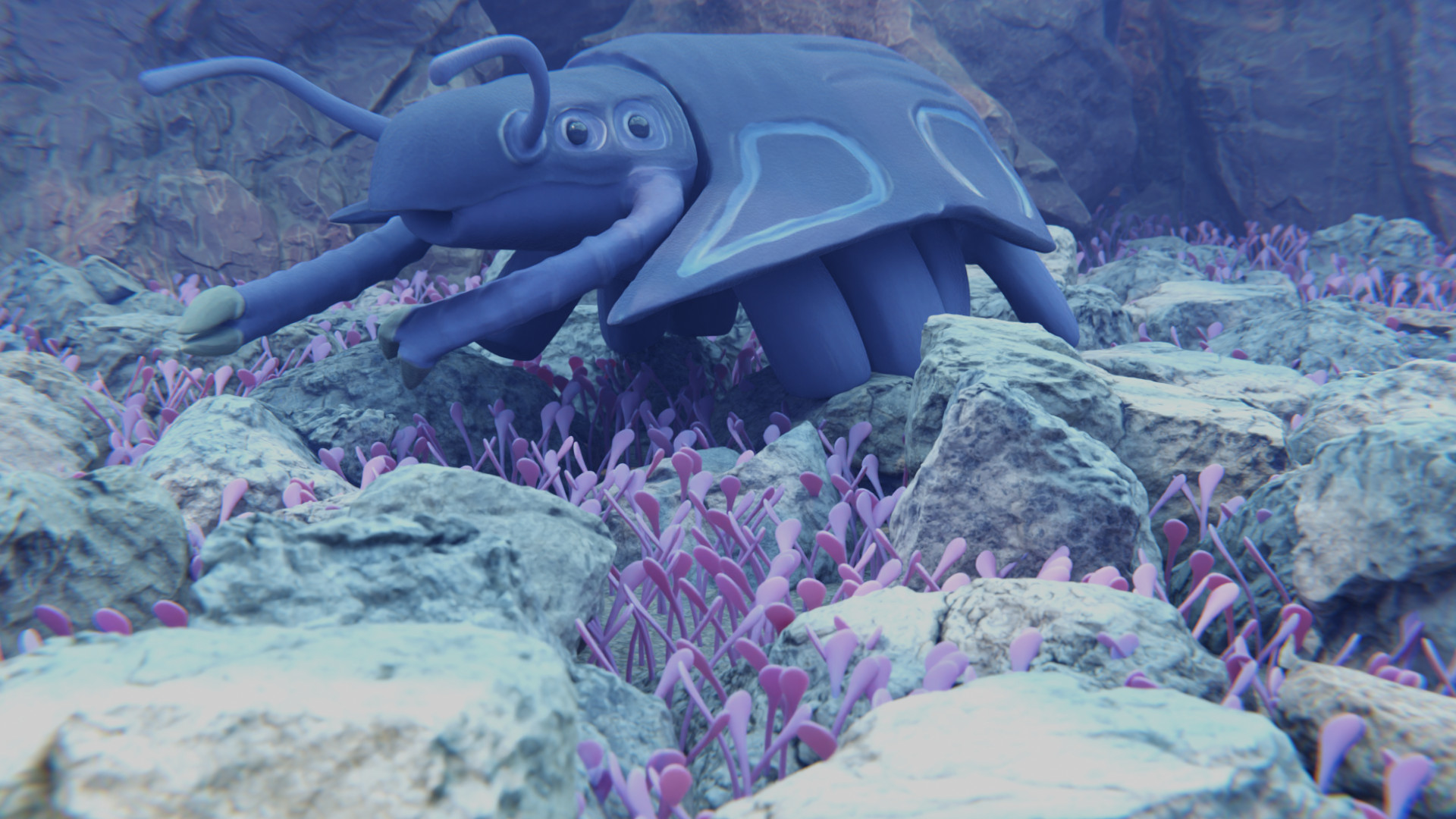Magnospina
Magnospina has evolved to match the amount of substrate plants due to the recent extinction of most previous large predators. The warmer climate made it able to grow to extremely large sizes. Pictured here a Magnospina frigus walks on the rocks above a sargrasso field. [Creature Design by Kipzilla]
Basic Information
Anatomy
Magnospina represent their ancestor a lot, the general body shape, internal layout etc. are all really similar, notable changes are the larger size, longer antenna, more shell covering the body, a new stomach extension called the gas stomach which fills itself with digestive gasses and gives extra buoyancy. Also notable is the change of the spiracles which now also serve a second purpose: mating. The females will choose their mates by power and by the color of their spiracles.
Genetics and Reproduction
Magnospina still reproduces almost the same as durospina. Females will release their pheromones when they are ready to mate, Every mating season the dominant male in the herd will cast every potential rival out of the herd and dig a large hole where all the females can release their gametes into, after they let their gametes loose the male will release his gametes and cover the hole back up. If a rival male shows up during the mating season they will have a fight which resembles a human wrestling match resulting in the stronger male gaining the right to reproduce. After the mating season the herd will move on and the rival males will be allowed back into the herd.
Growth Rate & Stages
Magnospina has multiple stages over the course of its life it begins as an egg, then it grows to a ‘’wander’’ then into an adult and if it lives long enough it will end up as an ‘’walker’’
Egg: After the mating happens the eggs will form from the male and female gametes, they will stay in the hole and grow to a size of 1cm, at that point it will break out of its egg and dig itself from the hole.
Wanderer: When it first climbs out of the hole it's around the size of 1cm and resembles its ancestor dyomisa during its wanderer phase it will stay in the general area around its birthplace where it will grow up to 50cm. When it reaches 50cm its shell will slowly harden and become more sturdy. After this growth it will join up with either an existing herd of magnospina or make one of its own with fellow wanderers
Adult: The moment a magnospina becomes fertile its an adult, it will follow its herd or lead one of its own if its able to overthrow the original herd leader by sheer power. They also first migrate north and south as adults leaving their birthplace and joining up with the yearly magnospinatrek.
Walker: When magnospina become too old it will become a walker, it won't be able to keep up with the herds and will be too weak to migrate in the yearly trek, because of this it will stay around the equator where it will live out the rest of its life until death.
Ecology and Habitats
Magnospina’s live all over the world in shallow seas where they feed on substrate growing plants and only enter deeper water to scavenge or for the yearly trek.
Every species of magnospina lives around their own habitat and they rarely enter each others habitats
Magnospina frigus: Lives on the east coast of Kub Shay and around Arctica
Magnospina tropicus: Lives in the shallow seas between Yama and Kub Shay
Magnospina nilaya: Lives around Niylan doesn't have a yearly trek, and uses sulphur dioxide instead of stomach gas for extra buoyancy.
Magnospina yamayus: Lives on the northwest coast of Yama
Dietary Needs and Habits
Magnospina is a herbivore, they live on the roots, stems, tubers and low hanging leaves of substrate growing plants. They move as a herd and eat an area barren before they move on to the next area, and then on and on and on.
Additional Information
Social Structure
Magnospina lives in loose herds with a dominant male as leader, He will cast out any rival male before the mating season but there are always challengers for the right to mate, the rest of the year the males and female help each other only with protection. Grazing happens individually and Magnospina that are too slow will be left behind. The male must maintain the support of the females however, and some may break off to follow a large and brightly colored male.
EXTINCT
Genetic Ancestor(s)
Scientific Name
Magnospina sp.
Origin/Ancestry
Paleotagmata
Lifespan
Magnospina frigus: 15 local years, Magnospina tropicus: 12 local years, Magnospina nilaya: 6 local years, Magnospina yamayus: 10 local years
Average Height
150 cm Magnospina frigus
145 cm Magnospina tropicus
100 cm Magnospina nilaya
125 cm Magnospina yamayus
Average Length
350 cm Magnospina frigus
300 cm Magnospina tropicus
200 cm Magnospina nilaya
275 cm Magnospina yamayus
Body Tint, Colouring and Marking
Geographic Distribution
Remove these ads. Join the Worldbuilders Guild












Comments